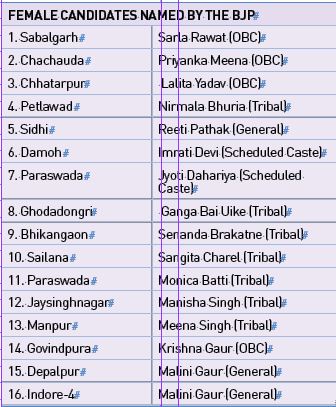


The Bharatiya Janata Party (BJP) plans to leverage the Women’s Reservation Bill in the upcoming elections in Madhya Pradesh. So far, the party has named 136 candidates in four different lists, of which only 16, or 12% of the total, are women. Notably among these 16 candidates, seven are tribal women. The BJP had, in the previous elections, fielded 24 women candidates. However, the candidates for 94 seats are yet to be announced, and it is expected that the number of women candidates will increase. The political battle between parties in the state has intensified to capture the votes of half the population. Parties are running aggressive campaigns using schemes such as “Ladli Behena” and “Nari Samman,” but seem hesitant to field women candidates in elections.
A look at the statistics from the past three assembly elections shows that the BJP on average fields 10% women candidates, while the Congress fields nearly 12% women candidates. In Madhya Pradesh, there are currently 5.52 crore total voters, out of which 2.67 crore (48.36%) are women. The number of female voters has increased in 41 districts of Madhya Pradesh since the last elections. Currently, there are 21 female MLAs out of 230 in the state assembly, with 14 from the BJP, six from the Congress, and one from the Bahujan Samaj Party (BSP).
The BJP included four women in the first list of 39 candidates, six in the second, one in the third, and five in the fourth list. Of the 16 candidates named, two are from Scheduled Castes, seven are tribal women, three are from the general category, and four are from Other Backward Classes (OBC). While the BJP and Congress field several women candidates, the number of women winning elections varies. In 2003, 15 of 18 female candidates fielded by the BJP won. In the same year, the Congress fielded the highest number of women candidates in the Vidhan Sabha elections (34), but only three won. In 2008, the BJP fielded 23 women candidates while the Congress fielded 28 — the parties won 15 and six of these seats respectively. In 2013, the BJP again fielded 23 women candidates, and 17 of them won.
The Congress, on the other hand, reduced its women candidates to 23 and had six winners. In 2018, the BJP fielded 24 women, with 11 winning. In the same year, the Congress increased the number of women candidates again, fielding 28 women, with nine victories. If political parties ensure the participation of women—constituting 33% of the state’s population—then the Madhya Pradesh Vidhan Sabha will comprise 76 female MLAs.